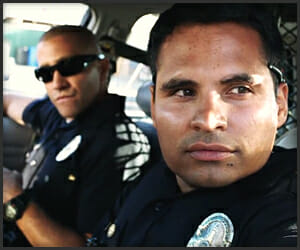End of Watch

David Ayer is best known for penning the action films U-571, The Fast and the Furious, S.W.A.T. and Training Day. In his latest offering, End of Watch (which he also directed), Ayer mines the familiar territory of the police drama, but turns the genre on its head—delivering a film with heart, humor and pathos in between moments of violence.
The film opens with a car chase through the streets of South Central Los Angeles (which, by the way, Hollywood, officially changed its name to South Los Angeles in 2003). The scene is captured from external and patrol car cameras, giving a real-time documentary feel that persists throughout the movie. The chase ends in a gunfight between suspects and LAPD officers Brian Taylor (Jake Gyllenhaal) and Mike Zavala (Michael Peña).
The two officers are cleared in the shooting and are welcomed back to Newton Division, located in one of the toughest, gang-infested neighborhoods in Los Angeles. We get a glimpse of the daily routines of LAPD personnel back at the station, both good and bad. It’s a testosterone-dominant atmosphere, filled with rookies and jaded veterans, where frat-boy antics and pranks are not uncommon, and women cops (played by America Ferrera, Cody Horn) seemingly have to be twice as tough as their male counterparts. But above it all, we see a close-knit community who step into the line of fire every day, trusting their partners to help them make it through each shift to log in another “end of watch” on their daily reports.
At its core, End of Watch is a buddy cop movie between Gyllenhaal and Peña, who are each at their top of their game. The Taylor-Zavala relationship comes across as a natural friendship that’s evolved through countless hours of patrol rides and bonding over the horrific crimes they’ve encountered. Some of the best scenes in the film are quieter ones in the squad car, filled with brotherly banter, humor and poignant discussions about life and death.
-

-

-

-

-

-

-

-

-

-

-

-

-

-

-

-

-

-

-

-

-

-

-

-

-

-

-

-

-

-

-

-

-

-

-

-

-

-

-

-








































